The Northern Prawn Fishery targets prawns in northern Australian waters.
AFMA manages this fishery by limiting how many boats can fish and regulating the gear they can use. Closures are also used to restrict fishing during times and in certain areas.
To fish in this fishery, operators must hold boat and gear fishing rights that allow them to use a boat and certain sized nets to catch prawns.
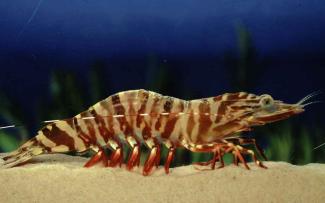
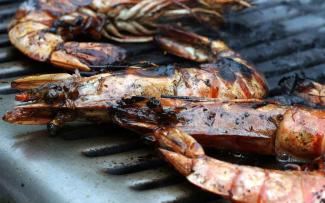
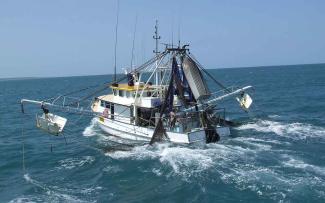
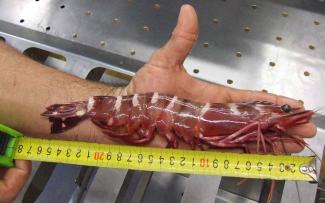
Target Species
| Species | Fishing Mortality* | Biomass** |
|---|---|---|
Penaeus indicus | G;Not subject to overfishing | G;Not overfished |
Penaeus merguiensis | G;Not subject to overfishing | G;Not overfished |
Penaeus esculentus | G;Not subject to overfishing | G;Not overfished |
Penaeus semisulcatus | G;Not subject to overfishing | G;Not overfished |
Metapenaeus endeavouri | G;Not subject to overfishing | G;Not overfished |
Metapenaeus ensis | G;Not subject to overfishing | G;Not overfished |
* Fishing mortality status relates to the level of fishing pressure on a stock – specifically, whether fishing mortality in the year being assessed is likely to result in the stock becoming overfished or prevent the stock from rebuilding from an overfished state. If fishing mortality exceeds either of these thresholds, a stock is considered to be subject to overfishing.
** Biomass status relates to how many fish there are – specifically, whether the biomass in the year being assessed is above the level at which the risk to the stock is considered to be unacceptable. The HSP defines this level as the limit reference point, below which the stock is considered to be overfished.
This fishery is managed by setting the total amount of net that can be used in a season along with adjustments to the length of the fishing season. This is different to many other fisheries managed by AFMA where the fishery is managed by setting the total amount of allowable catch for each target species.
Gear allowance
Gear statutory fishing rights entitle the holder to use a net with a certain headrope and footrope length. A gear right for operators using:
- twin (two nets) trawl nets is currently worth 9 cm of headrope length
- twin tongue (two nets), triple (three nets), or quad (four nets) trawl nets has a value of 8.1 cm per gear right.
Catch history
| Species | Catch 2024 (tonnes) | Catch 2023 (tonnes) | Catch 2022 (tonnes) | Catch 2021 (tonnes) |
|---|---|---|---|---|
| Banana prawns | 3875 | 6896 | 4100 | 3661 |
| Tiger prawns | 1198 | 1242 | 918 | 1026 |
| Endeavour prawns | 428 | 372 | 377 | 444 |
Value of catch
AUD $77.6 million (2023–24).
Fishing gear
Bottom trawl fishing gear is used in this fishery.
Read more about bottom trawl.
Location
The Northern Prawn Fishery is located off Australia’s northern coast from Cape York in Queensland to Cape Londonderry in Western Australia.
Major landing ports
- Cairns
- Darwin
- Karumba
- Most of the catch is frozen fresh on-board and periodically transferred onto motherships at sea.
Markets supplied
Prawns are frozen fresh on-board and sold in Australian markets and export markets including Japan and China.
Fishing season
- Season 1 (mainly banana prawns caught): 1 April – 15 June
- Season 2 (mainly tiger prawns caught): 1 August – end of November
Season end dates depend on catch rates and fishery may be closed early.
Management of catch
The Northern Prawn Fishery is managed through a series of controls, including:
- a limit on the amount of net that can be used
- a limit to the number of boats allowed to fish
- requirements to use turtle excluding devices and bycatch reduction devices in all trawl nets, and
- seasonal and area closures.
Licence to fish
Fishers must hold a valid boat fishing right to fish in this fishery. Fishers also need to have gear fishing rights that allow them to use a certain amount of net to catch fish in the fishery. These fishing rights are transferable to others.
In the fishery there are currently:
- 52 boat fishing rights (maximum number of vessels active at one time)
- 35,479 gear fishing rights.
Gear fishing rights entitle the holder to use a net with a certain headrope and footrope length. A gear right for operators using:
- twin (two nets) trawl nets is currently worth 9 cm of headrope length
- twin tongue (two nets), triple (three nets), or quad (four nets) trawl nets has a value of 8.1 cm per gear right.
Collecting data
Data about the catch and effort in the fishery is collected through the logbooks fishers have to fill out every time they fish. Logbooks record:
- the species and amount caught
- catch that is discarded
- the catch/release of any protected species and its life status
- set and haul times of each trawl event (shot)
- the location of each shot
- the type and amount of gear used.
Fishery closures
Seasonal closures to trawling serve a number of purposes. They ensure fishing occurs around times when prawns are most abundant and in the best condition for market. They also ensure enough prawns are available to breed.
Trawling is also banned during daylight hours for the second season to reduce the catch of egg-bearing female tiger prawns.
The first fishing season lasts for approximately 2.5 months. The second fishing season lasts for up to four months.
Cooperative management
AFMA and NPF Industry conducted a co-management trial in the fishery between 2009 and 2011.
The trial gave the industry a greater role in advising AFMA on operational and commercial matters in the fishery. The trial was a great success, resulting in NPF Industry Pty Ltd now being responsible for managing and organising:
- data collection and management
- a crew member observer program focusing on the impact on protected species
- a fishery independent monitoring program
- pre-season information sessions for crew and skippers
- approval to distribute fishery data and respond to NPF data requests.
Species sustainability
The status (health) of target species populations in the Northern Prawn Fishery is reported annually in the Fishery Status Reports compiled by the Australian Bureau of Agricultural and Resource Economics and Sciences (ABARES). In 2021, species status were as follows:
- white banana prawn – not subject to overfishing and not overfished
- red-legged banana prawn – not subject to overfishing and not overfished
- brown tiger prawn – not subject to overfishing and not overfished
- grooved tiger prawn – not subject to overfishing and not overfished
- blue endeavour prawn – not subject to overfishing and not overfished
- red endeavour prawn – not subject to overfishing and not overfished.
Species risk assessments
AFMA regularly monitors the effects of fishing activities upon marine species and habitats through ecological risk assessments. The assessment results help to prioritise the management, research, data collection and monitoring needs for the fishery.
After the risk assessment is complete, an ecological risk management strategy is developed to address how AFMA will manage the effects of fishing on marine species and habitats found to be at risk.
Go to the assessment and management report for the Northern Prawn Fishery.
Bycatch workplans
Developed by NPFI, the NPF has the Northern Prawn Fishery Bycatch Strategy (2020–2026) in place.
The strategy outlines ways to minimise the catch of species at high risk from the fishery. These species include threatened, endangered and protected species, some sharks and other non-targeted fish species.
Harvest strategy
A harvest strategy is used to help determine what the sustainable catch should be for the target species of the fishery. Fishing, environmental, and economic information is included in the harvest strategy, which helps to monitor and maintain the sustainability of the targeted species and maximise economic returns from the fishery.
All harvest strategies are developed in line with the Commonwealth Fisheries Harvest Strategy Policy and Guidelines.
Go to the Northern Prawn Fishery Harvest Strategy.
Export approvals
To export from an Australian commercial fishery, the fishery must be accredited by the Department of Climate Change, Energy, the Environment and Water website under the Environment Protection and Biodiversity Conservation Act 1999 (EPBC Act). This accreditation ensures that fisheries are managed in an ecologically sustainable way over time.
The NPF was granted an exemption from export restrictions under the EPBC Act for a period of five years until 6 January 2027. Further information about accreditation of the fishery under the EPBC Act can be found on the Department of Climate Change, Energy, the Environment and Water website.
Environmental accreditation
The Northern Prawn Fishery first received Marine Stewardship Council (MSC) certification in 2012. Following an independent assessment, the fishery was re-awarded MSC certification in 2018.
MSC certification is a science based third-party assessment process that assesses fisheries against strict environmental standards for sustainable fishing. Through the assessment process the NPF has demonstrated that it is well-managed and a sustainable source of seafood. The fishery undergoes annual audits to ensure it continues to meet certification requirements. More information can be found on the MSC website.
Marine reserves
Commonwealth marine reserves are areas established under Australian environmental law to help conserve the spectacular marine life in our oceans. They support ecologically sustainable use of our marine resources and provide special places for people to enjoy and appreciate the fantastic diversity of our marine habitats.
Marine reserves are sometimes known as marine protected areas or marine parks and are managed by the Department of Climate Change, Energy, the Environment and Water website.
More information about marine reserves can be found on the Department of Climate Change, Energy, the Environment and Water website.
Fishing in the fishery
There are rules that fishers must meet when fishing in the Northern Prawn Fishery. These include, but are not limited to:
- holding a valid boat fishing right and gear fishing rights
- using a vessel monitoring system
- adhering to area and time-based fishing closures
- carrying a scientific observer when requested to do so
- modifying gear to reduce catch of unwanted species.
Download a copy of the Northern Prawn Fishery Directions and Closures 2025 for Season 1 and Season 2 for a full description of all fishing requirements for this fishery.
Management plan
The Northern Prawn Fishery Management Plan 1995 outlines the area of the fishery, objectives, management controls and the granting of fishing rights.
AFMA recognises that managing fisheries involves a broad range of stakeholders including industry, scientists, environmental groups, the community and management.
Engaging with our stakeholders allows us to make informed decisions regarding fisheries management.
Fishing industry
Under co-management arrangements, the NPF Industry Pty Ltd (NPFI) is responsible for a number of functions including the management of catch and effort information, managing the crew member observer program, carrying out pre-season briefings, undertaking in-season monitoring and data collection, overseeing the collection of broodstock and catch reporting, and providing vessels to undertake the NPF spawning and recruitment surveys.
Prior to each fishing season, NPFI facilitates an information session to inform fishers of any new management arrangements that may impact their fishing activities. AFMA attends these sessions once a year which allows us to meet directly with fishers to discuss any concerns they might have, and also gain an understanding of current fishing trends and expected catches for the season.
The NPFI is also responsible for recruiting, training and supporting a crew member observer program. The program trains crew members in collecting valuable information on threatened species including sawfish, sea snakes, turtles, pipefish and other at-risk species.
Northern Prawn Fishery Management Advisory Committee
The Northern Prawn Fishery Management Advisory Committee is the advisory body for the Northern Prawn Fishery. The committee includes expertise in the area of fisheries management (AFMA), fishing industry, science and environment.
See the Northern Prawn Fishery Management Advisory Committee webpage for a summary of the latest discussions and outcomes from the committee.
Northern Prawn Fishery Resource Assessment Group
The Northern Prawn Fishery Resource Assessment Group provides research and scientific advice for the Northern Prawn Fishery. The group is composed of fishery scientists, fishing industry members, an economist and an AFMA member.
See the Northern Prawn Fishery Resource Assessment Group webpage for a summary of the latest discussions and outcomes from this group.
Recreational fishing
Prawn harvest by the recreational and Indigenous sectors is believed to be negligible in northern Australia.
Government departments
AFMA works closely with other government departments, such as Department of Agriculture, Fisheries and Forestry and the Department of Climate Change, Energy, the Environment and Water, which provide advice and guidance on both domestic and international fisheries policy.
State governments
AFMA manages prawn fishing in the area of the Northern Prawn Fishery. There are also other state and Northern Territory fisheries that operate in the same area and target other species. AFMA regularly communicates with state and Northern Territory fisheries agencies to manage any problems that might occur between fisheries.
A representative from the Queensland fisheries agency attends the Northern Prawn Fishery Management Advisory Committee meetings and provides input and advice.
- the Queensland Department of Primary Industries
- the WA Department of Primary Industries and Regional Development
- the NT Department of Agriculture and Fisheries.
Environmental non-government organisations
Representatives from environmental non-government organisations are engaged through several forums to provide advice on research and management issues. AFMA holds two to three environmental forums annually.
Management publications
Northern Prawn Fishery Directions and Closures 2025
Harvest Strategy for the Northern Prawn Fishery
Management Plan
Northern Prawn Fishery Management Plan 1995
Environment publications
Mitigating Sawfish Interactions in the Northern Prawn Fishery: Final Report – March 2025
Ecological risk assessment and management reports
Northern Prawn Fishery Bycatch Strategy
Northern Prawn Fishery Sawfish work plan
Industry gear innovations achieve bycatch reduction target in the Northern Prawn Fishery
Research publications
Development and simulation testing of a Harvest Strategy for Redleg Banana Prawns in the NPF
Modelling growth of red endeavour prawns using new ELEFAN and Bayesian growth models
Integrated Monitoring Program
Integrated Monitoring Program for the Northern Prawn Fishery – recruitment survey maps February 2025
Integrated Monitoring Program for the Northern Prawn Fishery – recruitment survey maps July 2024
Research plan
Northern Prawn Fishery Strategic research plan 2024–28
Northern Prawn Fishery Annual Research Statement 2025–26
Data summaries
The map below shows the sea area that is included in the fishery.
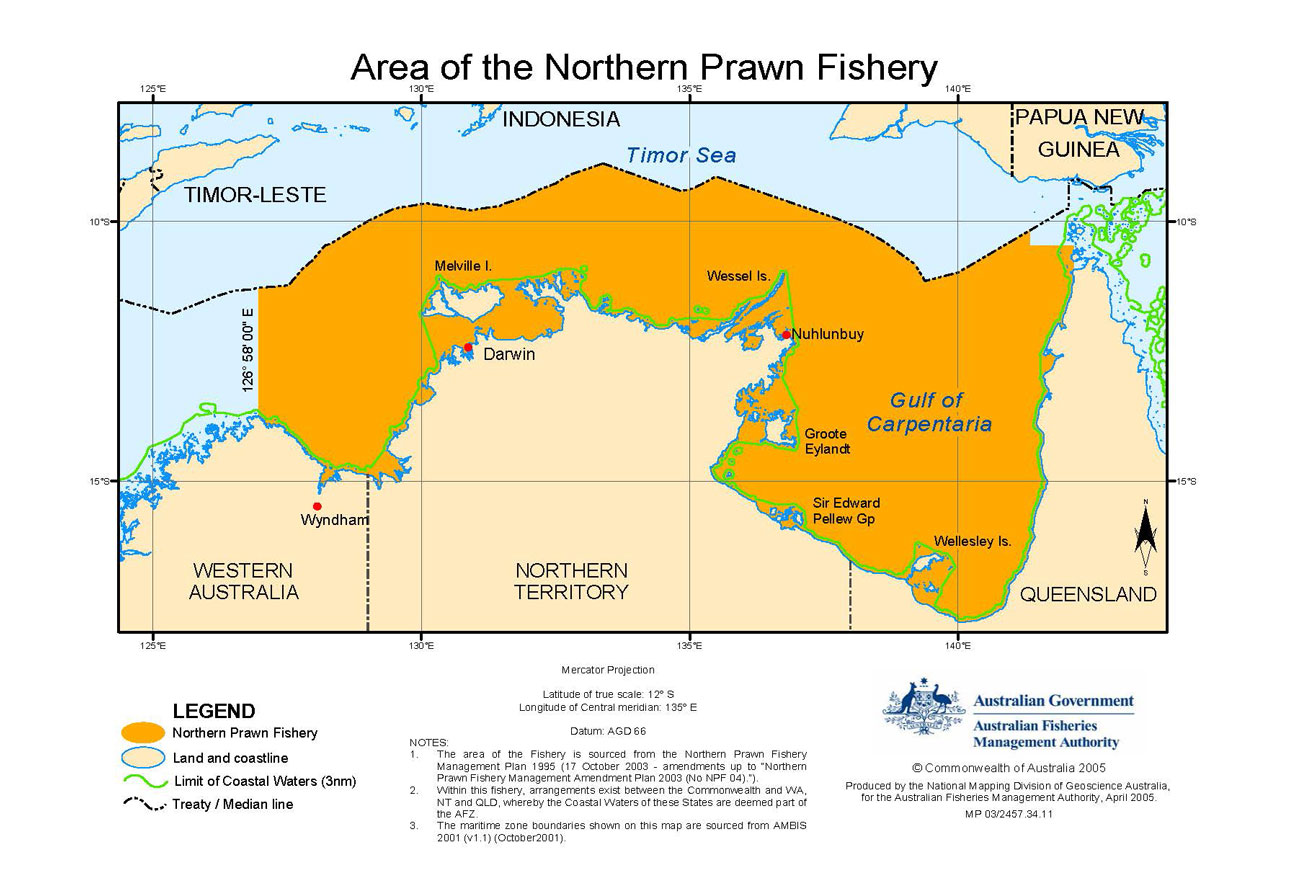
AFMA uses several methods to monitor the compliance of fishing activities and collect data on fish stocks. These include:
Onboard observers
One of the main monitoring methods used by AFMA is onboard scientific observers. Observers are employed by AFMA to go out on boats and independently record the catch, effort and biological information of each fishing trip. They take samples from the catch for scientific analysis.
Observers also record the length, weight and sex of target species caught during a trip and report on the other wildlife, the weather conditions, the composition of commercial catch and the fate of species caught as bycatch.
Boats in the fishery must carry an AFMA observer when requested by AFMA.
| Observer | 2024 | 2023 | 2022 | 2021 |
|---|---|---|---|---|
| Crew member observers | 987 days | 885 days | 862 days | 1099 days |
| Scientific observers | 168 days | 154 days | 98 days | 213 days |
Read more about the observer program.
Satellite tracking
A satellite monitoring system called a Vessel Monitoring System (VMS) is fitted to each boat. This system helps AFMA to monitor vessel position, course and speed. The tracking unit regularly transmits the information through a communications satellite to a land earth station. This information is sent by secure internet connection to a database at AFMA.
Read more about our satellite tracking program.
Cameras on fishing boats – electronic monitoring
AFMA is trialing electronic monitoring systems on some fishing boats in the NPF. These systems have sensors linked to surveillance cameras that record fishing activity. These recordings can then be collected and monitored by AFMA. Electronic monitoring gives fishers a cost-effective way to support monitoring and data collection. Read more about electronic monitoring of fishing boats.